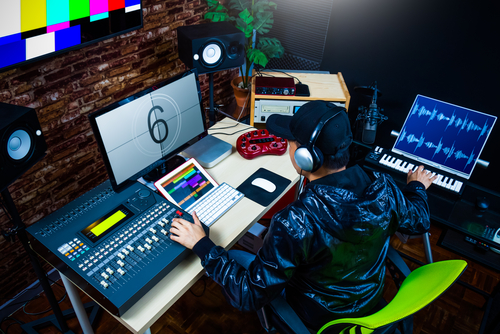 When considering a career that combines art with construction, a person may wonder what a background painter does. Background painters combine knowledge of fine art, color theory and design with skills in interpreting stories, technology and construction to create a background that will help tell a story and support the author’s or playwright’s vision. Knowing what a background painter does could help a person decide whether or not that career path is the right one for them.
When considering a career that combines art with construction, a person may wonder what a background painter does. Background painters combine knowledge of fine art, color theory and design with skills in interpreting stories, technology and construction to create a background that will help tell a story and support the author’s or playwright’s vision. Knowing what a background painter does could help a person decide whether or not that career path is the right one for them.
Support the Narrative of a Story
Background painters support the narrative of a story. They do this by adding both dimension and color to the scenery. While the sketch of the background might show a house and some trees, the painter can set the tone by making the house bright and clean versus decaying and dingy. The mood can be set with a crisp blue sky or an angry, gray one. Soft, smooth strokes create wispy clouds, while a lot of texture can create an effect that looks like rain, fog or snow. The painter may even add scenery that is thought-provoking, inspiring or controversial to tip the perception of the narrative to a particular direction.
Complete the Sketch Artist’s Vision
Another responsibility of a background painter is to complete the sketch artist’s vision. Some sketch artists only create a basic foundation for the scenery or background, leaving a lot up to the painter. The painter would work closely with the art director, sketch artist and other artists on the project. In some cases, painters are given a lot of leeway in how they choose to complete the sketch artist’s vision. Many background painters become known for a particular style or mood that they can create in a background. They may use color, space, shadows, textures or outlines to complete the vision for the background.
Use Specialty Techniques for Creating Desired Aesthetics
Much like house painters can use different techniques when adding color to the interior or exterior walls, background painters also use special techniques for creating a certain aesthetic. They might add glitter, shellac or sand to the paint to bring more reflection or texture into the finished look. They might thin the paint and build it up in layers of various shades. A painter could thicken the paint to create a more dramatic look. Painters could also use different applicators, such as sponges, natural bristle brushes, acrylic brushes, rollers and found objects when applying color to the background. In some cases, they might use different types of paint or combine paint with some other substrate, such as chalk or ink.
Add Artistic Effects to Video, Film or Animations
According to the Bureau of Labor Statistics, background painters add to the aesthetics of a film, animation or video. They may also create backgrounds for still photos. Some of these functions overlap with video artists, illustrators and fine art painters. For example, a background painter might create a background piece of scenery that is two-dimensional, flat, one-piece and large. On the other hand, they might create a three-dimensional, small background for use with clay figures. They could create these artistic effects with watercolors, acrylics or oil-based paints. In some cases, the original sketches are layered with the painting, especially when turning a book into an animation.
Background painters provide artistic effects that visually bring a story together. Their knowledge of spatial relationships, textures, colors, perception and movement comes together with skills for working on different materials and creating different moods or emotions. By understanding what a background painter does, a person can make an informed decision about how to proceed with a career in the fine arts and crafts.
Related Resources:
What Degree Do I Need To Be An Animator?
What Can I Do With An Art Degree?
What is the Median Salary for an Animator?
What is a Typical Day in the Life of an Animator?
Is it Easy to Work for Myself as an Animator?
Are Their Certain Parts of the Country Where It’s Easier to Find a Job as an Animator?
What Kind of Company Does a 3D Modeler Work For?
Should I Get a Master’s to Become a 3D Modeler?
What Kind of Fields Use a 3D Modeler?
Is it Easy to Work for Yourself as a 3D Modeler?
What is a “Good” Salary for a 3D Modeler?
What are the Best Programs for a 3D Modeler to Learn?
Can You Be an Animator and Work on Movies that aren’t Animated?
How Do You Become an Animator?
